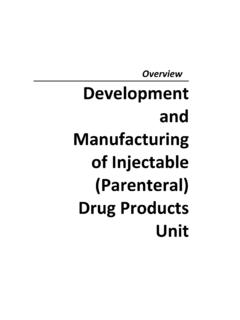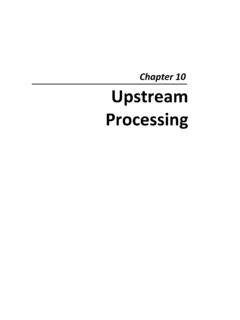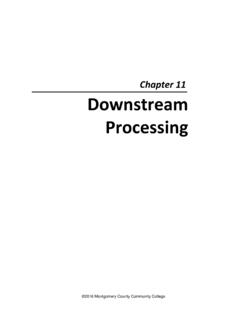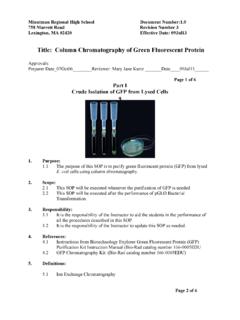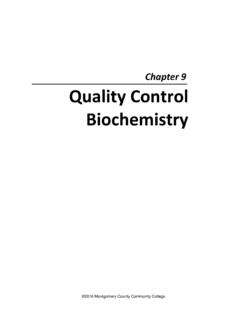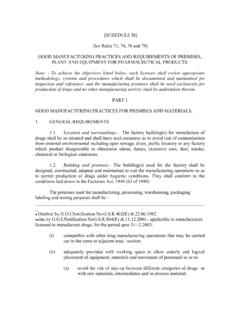Transcription of Chapter 10 Upstream Processing - Biomanufacturing
1 2016 Montgomery County Community College Chapter 10 Upstream Processing Objectives 380 Chapter 10 - Upstream Processing This Chapter provides an overview of the key elements for operation of a Biomanufacturing Upstream Processing production area. Upon completion of this Chapter the student will be able to: distinguish between mammalian and microbial Upstream Processing describe the contribution of the areas of dispensing, media preparation, and fermentation/cell culture to the Upstream process as a whole describe proper methods to avoid cross-contamination in the dispensary, such as the use of airflow booths and following cleaning protocol explain the in-process controls for assessing media components illustrate the major types of bioreactors and associated instruments used for Upstream Biomanufacturing evaluate situations in order to make appropriate aseptic decisions obtain and interpret various assay values, apply the data.
2 And determine and execute appropriate responses for the Upstream process define and describe methods of contamination control that are directly influenced by the Upstream Biomanufacturing personnel, such as aseptic techniques for open Processing , closed Processing , and helium testing that can increase the Biomanufacturing success rate identify critical process parameters for cell growth and protein production and understand how they are controlled by the Biomanufacturing operator explain automated and manual cell counting techniques and determine accurate cell count values from given laboratory data describe Processing steps for primary recovery/harvest apply filtration and centrifugation theory and mechanics to appropriate fermentation and harvest steps Terms Introduction to Biomanufacturing 381 Active Pharmaceutical Ingredient (API): any substance or mixture of substances intended for use in the manufacture of a drug (medicinal) product.
3 When used in the production of a drug it becomes an active ingredient in the drug product Ampoule: a small sealed vial used to contain and preserve substances that must be protected from air and contaminants Analytical method: laboratory procedure used to analyze a sample Animal-derived materials: Animal Sourced/Animal-Derived Material is defined as a raw material that is created from or processed in part from animals. Materials of Special Consideration are not considered animal-derived; these include materials of animal origin defined as Special considerations as described in EMA/410/01. These are materials that are unlikely to be sources of TSE/BSE when produced in accordance with EMA/410/01 guidelines. Examples include collagen, gelatin, tallow derivatives, milk and milk derivatives, wool derivatives, amino acids, etc.
4 Batch: a specific quantity of material produced in a process or series of processes that is expected to be homogenous within specified limits; may also be referred to as a lot. Batch record: a record of all materials and proportions used to produce a batch Bioreactor: a device or system meant to grow cells in cell culture Cell Bank (working): cells grown from those maintained in a master cell bank with well- characterized stability and uniformity Centrifugation: the process of separating the lighter constituents of a solution, mixture, or suspension from the heavier constituents by centrifugal force Clarification: the removal of small amounts of fine, particulate solids from liquids Clean In Place (CIP): a method of cleaning the interior surfaces of pipes, vessels, process equipment, and associated fittings without disassembly Conductivity.
5 A measure of a material's ability to conduct an electric current Cryovial: a small vial designed for the storage of biological materials, cells, etc., under extremely low temperatures Culture initiation: at the beginning of each batch of a campaign, a vial of cells is transported to an inoculum prep room; the culture is then initiated by thawing the vial. Dewar: a storage vessel which provides thermal insulation by interposing a partial vacuum between the inside and the outside walls of the vessel; cell cryovials are stored in liquid nitrogen within a Dewar Dissolved Oxygen (DO): the amount of oxygen gas that is dissolved in the media and is available to cells 382 Chapter 10 - Upstream Processing Feed stream: consists of cells and culture media; the feed stream is cooled and microfiltered at a temp of 4 degrees Celsius Fermentation: biopharmaceutical fermentation involves the culture of yeast or microbial cells for the purposes of protein drug production; most fermentations are aerobic.
6 This is not to be confused with biochemical fermentation, which is the breakdown of complex carbon compounds into simpler compounds of water, carbon dioxide, etc. Generation number: the population-doubling level of the cell bank HEPA: a commonly used acronym for High Efficiency Particulate Arrestance HVAC: a commonly used acronym for Heating, Ventilation, and Air Conditioning used for indoor environmental control Lot: a specific quantity of material produced in a process or series of processes that is expected to be homogenous within specified limits; may also be referred to as a batch. Non-Animal-Derived Materials: materials used in the manufacture of biopharmaceuticals that are accompanied by a Certificate of Origin (COO) stating that the material was not derived from animal sources Permeate: product (including media and other proteins similar in size) smaller than the filter pore size that passes through the pores of the filter and enters the filter housing where it can be collected pH: a measure of the acidity or alkalinity of a solution Retentate: consists of rejected species (cell debris, proteins larger than the filter s pore size, etc.)
7 That remain in the recirculation loop until removed Spinner flask: a flask used to culture cells; the side arms of the flask are used for drawing samples from the culture and transferring the culture from one vessel to another Steam In Place (SIP): SIP occurs when bioreactor vessels and piping are sterilized with clean steam to establish a sterile boundary Upstream Processing : process incorporating dispensing, media preparation, and cell culture WC: inches water column; a measurement of pressure Introduction to Biomanufacturing 383 Introduction to Upstream Processing Overview The Upstream Biomanufacturing technician s tasks center around microscopic, living cells. The main objective of Upstream manufacturing is to create the environment necessary for cells to make the target protein.
8 These proteins serve various medicinal purposes. Biomanufacturing is used to produce products such as therapeutic proteins, antibiotics, hormones, enzymes, amino acids, blood substitutes, and alcohol. They can be used as antigens in vaccine production or function as therapeutic hormones, enzymes, or antibodies against a particular disease or disorder. Lymphoma, rheumatoid arthritis, diabetes mellitus, and growth hormone insufficiency are a few of the human afflictions that biopharmaceuticals can successfully treat by reacting with specific protein targets. The product of interest may be excreted from the cells (generally in the case of mammalian cells) or may be intracellular (generally in the case of bacterial cells). In Biomanufacturing , Upstream Processing is the growth of either bacterial or cell culture-based protein products, referred to as microbial fermentation or mammalian cell culture respectively.
9 These disease-fighting proteins are collectively called Active Pharmaceutical Ingredients, or APIs. The efforts of Upstream technicians may be focused on one of the stages leading up to large-scale production: discovery research or clinical trials. Or the technician may be helping to produce a substance that has passed all phases of clinical trials and is approved for commercial sale. In clinical or commercial production, exacting attention to every Processing step is critical to a successful batch. The batch record is the set of instructions that must be followed exactly as written and documented immediately following each action. The remainder of this Chapter will outline how the cells are obtained and grown to produce the protein of interest and will discuss the subsequent initial separation of the desired protein from the spent cells.
10 Cells and proteins The cells that Upstream technicians will care for in every step of the Upstream process have been intensively studied for many years. The Dewar room, where cells are kept frozen in liquid nitrogen (LN2), may be the most valuable room in the Biomanufacturing plant. A Dewar is a specialized vessel that provides the environment to keep cell processes in temporary frozen suspension. The cell lines, contained in cryovials in the Dewar vessels, have been subject to many years of exacting research. Since they have been intensely studied, they are of great value. Why are these cells unique? First, the cells must have the required transfected gene that expresses the desired API. Transfection of a cell introduces a set of genetic instructions that are not native to the cell that codes for the desired protein.
